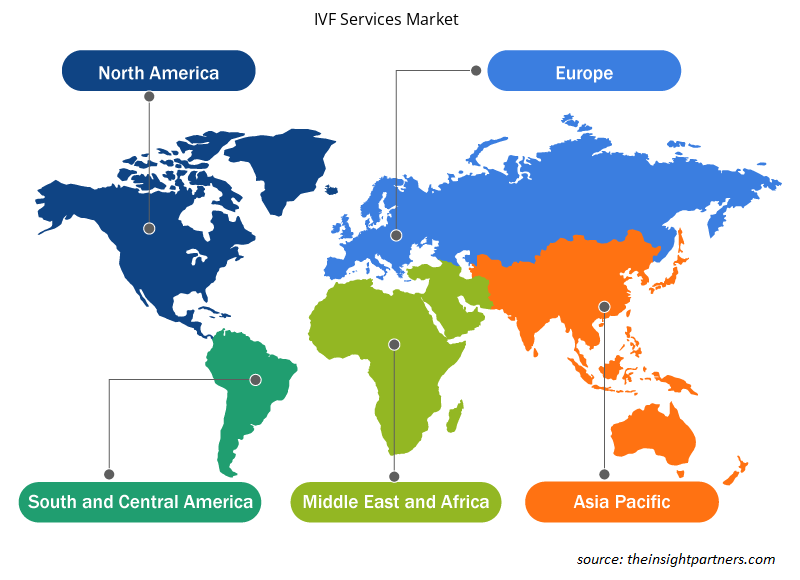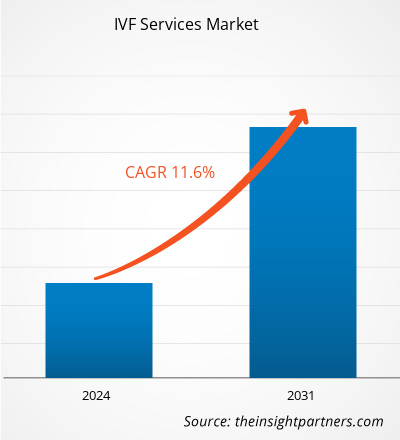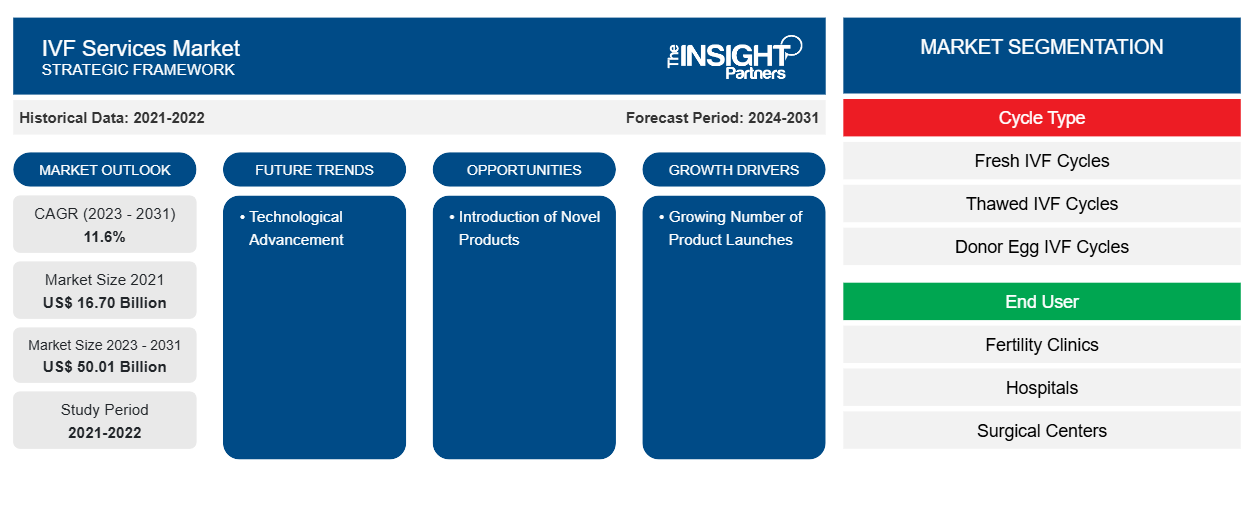Das Marktvolumen für IVF-Dienstleistungen wurde auf 16,70 Milliarden US-Dollar im Jahr 2021 und XX Millionen US-Dollar im Jahr 2023 geschätzt und soll bis 2031 50,01 Milliarden US-Dollar erreichen. Bis 2031 wird eine durchschnittliche jährliche Wachstumsrate (CAGR) von 11,6 % erwartet. Die zunehmende Zahl von Unfruchtbarkeitsfällen, die steigende Zahl von Fruchtbarkeitskliniken und Unfruchtbarkeitsdiensten mit staatlicher Unterstützung sowie die Integration künstlicher Intelligenz in die In-vitro-Fertilisation werden voraussichtlich auch weiterhin die wichtigsten Trends auf dem Markt für IVF-Dienstleistungen bleiben .
Marktanalyse für IVF-Dienstleistungen
IVF oder In-vitro-Fertilisation ist eine Fruchtbarkeitstherapie, bei der Eizellen aus den Eierstöcken einer Frau entnommen und außerhalb des Körpers mit Spermien befruchtet werden. Der Schritt umfasst mehrere Schritte und kann von Paaren oder Einzelpersonen mit Fruchtbarkeitsproblemen in Anspruch genommen werden. Derzeit bieten weltweit verschiedene IVF-Kliniken und -Zentren IVF-Dienste an.
Aufgrund verschiedener Faktoren, wie der zunehmenden Zahl später Eheschließungen und der zunehmenden altersbedingten Unfruchtbarkeit , sinkt die Geburtenrate weltweit stetig . Prognosen zufolge wird die globale Geburtenrate bis 2030 auf 2,4 Kinder pro Frau und bis 2050 auf 2,2 Kinder pro Frau sinken. Ungefähr 12 % der Frauen im Alter zwischen 15 und 44 Jahren in den USA haben unabhängig von ihrem Familienstand Schwierigkeiten, schwanger zu werden oder eine Schwangerschaft auszutragen. Außerdem können ungefähr 6,0 % der verheirateten Frauen im Alter zwischen 15 und 44 Jahren in den USA auch nach einem Jahr des Versuchens nicht schwanger werden (Unfruchtbarkeit). Somit führt die sinkende Geburtenrate zu einer deutlichen Steigerung der Nachfrage nach In-vitro-Fertilisationsleistungen (IVF), die das Fruchtbarkeitsfenster bei Männern und Frauen beeinflussen.
Marktübersicht für IVF-Dienstleistungen
Die zunehmende Zahl von Unfruchtbarkeitsfällen, die steigende Zahl von Fruchtbarkeitskliniken und Unfruchtbarkeitsdiensten mit staatlicher Unterstützung sowie die wachsende Zahl von Produkteinführungen und -entwicklungen. Die hohen Verfahrenskosten der Reproduktionstechniken und die mit der Unfruchtbarkeitsbehandlung verbundenen Risiken hemmen jedoch das Marktwachstum. Der globale Markt für IVF-Dienste ist nach Regionen unterteilt in Nordamerika, Europa, Asien-Pazifik, Naher Osten und Afrika sowie Süd- und Mittelamerika. Die Region Europa hält den größten Marktanteil, während die Region Asien-Pazifik die am schnellsten wachsende Region ist. Faktoren wie eine Zunahme der Unfruchtbarkeitsbehandlung durch IVF und ART. Die wachsende Unterstützung durch die Regierung durch verschiedene Programme, die steigende Zahl von Fruchtbarkeitszentren in den Ländern und die sinkende Geburtenrate bei Frauen werden das Marktwachstum in der Region in den Prognosejahren wahrscheinlich steigern.
Passen Sie diesen Bericht Ihren Anforderungen an
Sie erhalten kostenlos individuelle Anpassungen an jedem Bericht, einschließlich Teilen dieses Berichts oder einer Analyse auf Länderebene, eines Excel-Datenpakets sowie tolle Angebote und Rabatte für Start-ups und Universitäten.
-
Holen Sie sich die wichtigsten Markttrends aus diesem Bericht.Dieses KOSTENLOSE Beispiel umfasst eine Datenanalyse von Markttrends bis hin zu Schätzungen und Prognosen.
Treiber und Chancen auf dem Markt für IVF-Dienstleistungen
Wachsende Zahl von Produkteinführungen begünstigt Marktentwicklung
Unternehmen auf dem Markt für IVF-Dienstleistungen betreiben verstärkt Forschung und Entwicklung, um innovativere Produkte auf den Markt zu bringen. Die neuen IVF-Zyklen mit aufgetauten Zellen, IVF-Zyklen mit gespendeten Eizellen, Mikromanipulatorsysteme und Inkubatoren ermöglichen die Einführung fortschrittlicher Zelltechnologien, die die Verfahrensergebnisse verbessern. Im Januar 2021 kündigte Royal Philips, ein weltweit führendes Unternehmen im Bereich Gesundheitstechnologie, eine mehrjährige Partnerschaft mit Merck an, einem führenden Wissenschafts- und Technologieunternehmen, um digitale Lösungen in klinischer Qualität für hochgradig personalisierte Fruchtbarkeitsbehandlungen zu entwickeln. Es wird erwartet, dass eine zunehmende Anzahl von Produkteinführungen, Fusionen und Übernahmen sowie Entwicklungen den Markt für IVF-Dienstleistungen antreiben wird.behaviour to introduce more innovative products. The new thawed IVF cycles, donor egg IVF cycles, micromanipulator systems, and
Durchführung von Sensibilisierungskampagnen – Eine Chance inder IVF-Dienstleistungsmarkt
Die Aufklärungskampagnen tragen wesentlich dazu bei, die Reichweite von IVF-Technologien und -Therapien in der Bevölkerung zu erhöhen. Solche Kampagnen bergen auch erhebliches Potenzial für die Förderung neuer IVF-Zentren, den Informationsaustausch und Diskussionen. So wurde beispielsweise die erste Novemberwoche 2022 als Europäische Fruchtbarkeitswoche 2022 begangen. Die Woche wurde genutzt, um politische Entscheidungsträger in ganz Europa aufzufordern, den Zugang und die Qualität bestehender Unfruchtbarkeitsbehandlungen zu verbessern. Außerdem unternehmen Organisationen wie Fertility Europe konkrete Schritte, um die richtigen Informationen über Unfruchtbarkeitsbehandlungen zu verbreiten. Im Jahr 2022 wird die EFW die ganze Woche der Aufklärung über den Weg der Fruchtbarkeit der Patientinnen und die Schwierigkeiten widmen, mit denen sie oft zu kämpfen haben. Daher wird erwartet, dass die Durchführung geeigneter Aufklärungskampagnen den Unternehmen robuste Präsentationsplattformen bietet und so Wachstumschancen bietet, um die Umsätze innerhalb des dynamischen Ökosystems anzukurbeln.EFW will dedicate the whole week to bringing awareness to the patient's fertility journey and the difficulties they often have to deal with. Thus, conduction of appropriate awareness campaigns is expected to provide robust showcasing platforms for companies, thereby offering growth opportunities to propel revenues within the dynamic ecosystem.
Segmentierungsanalyse des Marktberichts zu IVF-Diensten
Wichtige Segmente, die zur Ableitung der Marktanalyse für IVF-Dienste beigetragen haben, sind Zyklustyp und Endbenutzer.
- Basierend auf dem Zyklustyp ist der Markt für IVF-Dienstleistungen in IVF-Zyklen, aufgetaute IVF-Zyklen und IVF-Zyklen mit gespendeten Eizellen unterteilt. Das Segment der frischen IVF-Zyklen hatte im Jahr 2023 den größten Marktanteil; außerdem wird erwartet, dass dasselbe Segment im Prognosezeitraum den höchsten CAGR-Prozentsatz auf dem Markt verzeichnet.
- Nach Endverbrauchern ist der Markt in Krankenhäuser, Fruchtbarkeitskliniken, chirurgische Zentren und klinische Forschungsinstitute unterteilt. Das Segment der Fruchtbarkeitszentren hatte 2023 den größten Marktanteil; außerdem wird erwartet, dass das Segment zwischen 2023 und 2031 die höchste durchschnittliche jährliche Wachstumsrate (CAGR) auf dem Markt verzeichnet.
Marktanteilsanalyse für IVF-Dienstleistungen nach geografischer Lage
Der geografische Umfang des IVF-Dienstleistungsmarktberichts ist hauptsächlich in fünf Regionen unterteilt: Nordamerika, Asien-Pazifik, Europa, Naher Osten und Afrika sowie Südamerika/Süd- und Mittelamerika. Nordamerika hat den IVF-Dienstleistungsmarkt nach Europa dominiert. Die Rate der Unfruchtbarkeitsbehandlungen nimmt im ganzen Land zu. Basierend auf dem Fertility Clinic Success Rates Report 2018 des CDC wurden im Jahr 2018 in 456 berichtenden Kliniken in den Vereinigten Staaten 306.197* ART-Zyklen durchgeführt, was zu 73.831 Lebendgeburten (Geburten eines oder mehrerer lebender Säuglinge) und 81.478 lebend geborenen Säuglingen führte. Nordamerika hatte 2023 den größten Anteil. Eine Neigung zu technisch fortschrittlichen Produkten und die Präsenz globaler Marktakteure sind Faktoren, die zur Dominanz des nordamerikanischen IVF-Dienstleistungsmarktes beitragen. Der Asien-Pazifik-Raum wird in den kommenden Jahren voraussichtlich mit der höchsten CAGR wachsen.
Regionale Einblicke in den Markt für IVF-Dienste
Die regionalen Trends und Faktoren, die den IVF-Dienstleistungsmarkt während des Prognosezeitraums beeinflussen, wurden von den Analysten von Insight Partners ausführlich erläutert. In diesem Abschnitt werden auch die Marktsegmente und die Geografie von IVF-Dienstleistungsmärkten in Nordamerika, Europa, im asiatisch-pazifischen Raum, im Nahen Osten und Afrika sowie in Süd- und Mittelamerika erörtert.

- Erhalten Sie regionale Daten zum IVF-Dienstleistungsmarkt
Umfang des Marktberichts zu IVF-Diensten
| Berichtsattribut | Details |
|---|---|
| Marktgröße im Jahr 2021 | 16,70 Milliarden US-Dollar |
| Marktgröße bis 2031 | 50,01 Milliarden US-Dollar |
| Globale CAGR (2023 - 2031) | 11,6 % |
| Historische Daten | 2021-2022 |
| Prognosezeitraum | 2024–2031 |
| Abgedeckte Segmente |
Nach Zyklustyp
|
| Abgedeckte Regionen und Länder |
Nordamerika
|
| Marktführer und wichtige Unternehmensprofile |
|
Marktteilnehmerdichte: Der Einfluss auf die Geschäftsdynamik
Der Markt für IVF-Dienstleistungen wächst rasant, angetrieben durch die steigende Nachfrage der Endnutzer aufgrund von Faktoren wie sich entwickelnden Verbraucherpräferenzen, technologischen Fortschritten und einem größeren Bewusstsein für die Vorteile des Produkts. Mit steigender Nachfrage erweitern Unternehmen ihr Angebot, entwickeln Innovationen, um die Bedürfnisse der Verbraucher zu erfüllen, und nutzen neue Trends, was das Marktwachstum weiter ankurbelt.
Die Marktteilnehmerdichte bezieht sich auf die Verteilung der Firmen oder Unternehmen, die in einem bestimmten Markt oder einer bestimmten Branche tätig sind. Sie gibt an, wie viele Wettbewerber (Marktteilnehmer) in einem bestimmten Marktraum im Verhältnis zu seiner Größe oder seinem gesamten Marktwert präsent sind.
Die wichtigsten auf dem IVF-Dienstleistungsmarkt tätigen Unternehmen sind:
- Max Healthcare,
- Bloom IVF,
- CCRM Fruchtbarkeit,
- OXFORD FERTILITY,
- Gesundheit schaffen (Fruchtbarkeit schaffen),
- Medicover,
Haftungsausschluss : Die oben aufgeführten Unternehmen sind nicht in einer bestimmten Reihenfolge aufgeführt.

- Überblick über die wichtigsten Akteure auf dem IVF-Dienstleistungsmarkt
Neuigkeiten und aktuelle Entwicklungen zum IVF-Dienstleistungsmarkt
Der Markt für IVF-Dienstleistungen wird durch die Erhebung qualitativer und quantitativer Daten nach Primär- und Sekundärforschung bewertet, die wichtige Unternehmenspublikationen, Verbandsdaten und Datenbanken umfasst. Im Folgenden finden Sie eine Liste der Entwicklungen auf dem Markt für IVF-Dienstleistungen und -Strategien:
- Im April 2023 gab Cryoport, Inc., ein weltweit führender Anbieter innovativer temperaturgesteuerter Lieferkettenlösungen für die Biowissenschaftsbranche und ein führender Anbieter von Lieferkettenlösungen für die Märkte der Reproduktionsmedizin, eine mehrjährige Vereinbarung mit Inception Fertility bekannt. Inception Fertility betreibt The Prelude Network® (Prelude), das größte und am schnellsten wachsende technologieorientierte Netzwerk von Fruchtbarkeitszentren in Nordamerika. (Quelle: Prelude Fertility, Pressemitteilung, 2024)
- Im April 2023 hat The Prelude Network, ein führender Anbieter umfassender Fruchtbarkeitsdienste in Nordamerika, eine exklusive Partnerschaft mit Future Family (FF) angekündigt, einer nationalen Plattform für Familiengründung mit flexiblen Finanzplänen und Concierge-Support-Diensten. Ziel der Partnerschaft ist es, den finanziellen Zugang zu erstklassigen Fruchtbarkeitsdiensten zu erweitern und den Patienten mehr finanzielle Optionen und ein klares Verständnis der Behandlungskosten zu bieten. Quelle: (Prelude Fertility, Pressemitteilung, 2024)
Marktbericht zu IVF-Dienstleistungen – Abdeckung und Ergebnisse
Der Bericht „Marktgröße und Prognose für IVF-Dienste (2021–2031)“ bietet eine detaillierte Analyse des Marktes, die die folgenden Bereiche abdeckt:
- Marktgröße und Prognose auf globaler, regionaler und Länderebene für alle wichtigen Marktsegmente, die im Rahmen des Projekts abgedeckt sind
- Marktdynamik wie Treiber, Beschränkungen und wichtige Chancen
- Wichtige Zukunftstrends
- Detaillierte PEST/Porters Five Forces- und SWOT-Analyse
- Globale und regionale Marktanalyse mit wichtigen Markttrends, wichtigen Akteuren, Vorschriften und aktuellen Marktentwicklungen
- Branchenlandschaft und Wettbewerbsanalyse, einschließlich Marktkonzentration, Heatmap-Analyse, prominenten Akteuren und aktuellen Entwicklungen
- Detaillierte Firmenprofile
- Historische Analyse (2 Jahre), Basisjahr, Prognose (7 Jahre) mit CAGR
- PEST- und SWOT-Analyse
- Marktgröße Wert/Volumen – Global, Regional, Land
- Branchen- und Wettbewerbslandschaft
- Excel-Datensatz
Aktuelle Berichte
Erfahrungsberichte
Grund zum Kauf
- Fundierte Entscheidungsfindung
- Marktdynamik verstehen
- Wettbewerbsanalyse
- Kundeneinblicke
- Marktprognosen
- Risikominimierung
- Strategische Planung
- Investitionsbegründung
- Identifizierung neuer Märkte
- Verbesserung von Marketingstrategien
- Steigerung der Betriebseffizienz
- Anpassung an regulatorische Trends























 Kostenlose Probe anfordern für - Markt für IVF-Dienstleistungen
Kostenlose Probe anfordern für - Markt für IVF-Dienstleistungen